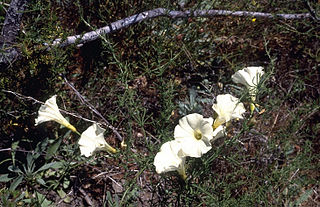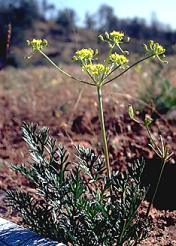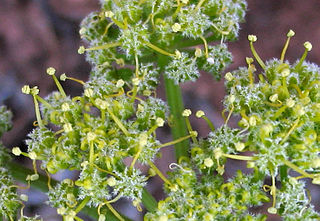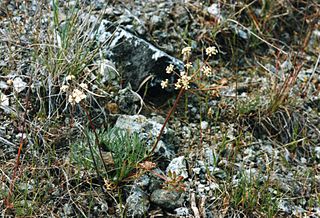
Eriogonum alpinum is a species of wild buckwheat known by the common name Trinity buckwheat.

Eryngium aristulatum, known by the common names California eryngo and Jepson's button celery, is a species of flowering plant in the family Apiaceae.
Arctostaphylos luciana is a species of manzanita known by the common name Santa Lucia manzanita, is endemic to California.

Arctostaphylos obispoensis is a species of manzanita, known by the common names bishop manzanita and serpentine manzanita, endemic to California.

Calystegia stebbinsii is a rare species of morning glory known by the common name Stebbins' false bindweed. It is endemic to the Sierra Nevada foothills and the Tehachapi Mountains in Kern County, of California. It grows in unique habitat in chaparral on gabbro soils. It is a federally listed endangered species.
Eryngium pinnatisectum is an uncommon species of flowering plant in the family Apiaceae, known by the common names Tuolumne eryngo and Tuolumne button celery.

Lomatium congdonii, known by the common names Mariposa desertparsley and Congdon's lomatium, is a species of flowering plant in the carrot family.
Hackelia brevicula is a species of flowering plant in the borage family known by the common name Poison Canyon stickseed.
Linanthus killipii, known by the common name Baldwin Lake linanthus, is a rare species of flowering plant in the phlox family.

Lomatium caruifolium, known by the common name alkali desertparsley, is a species of flowering plant in the carrot family.

Lomatium dasycarpum is a species of flowering plant in the carrot family known by the common name woollyfruit desertparsley. It is native to California and Baja California, where it is widespread throughout many of the mountain ranges, including the Peninsular, Sierra Nevada, and California Coast Ranges, and in valleys.

Lomatium engelmannii is an uncommon species of flowering plant in the carrot family known by the common name Engelmann's desertparsley, or Engelmann's lomatium. It is native to the Klamath Mountains of southern Oregon and northern California, where it is a member of the local serpentine soils flora.
Lomatium marginatum is a species of flowering plant in the carrot family known by the common name butte desertparsley. It is endemic to California, where it is known from mountains, valley, and grassland habitat, including serpentine, in the northern half of the state. It is a perennial herb growing up to about half a meter tall from a small taproot. There is no stem, and the leaves and inflorescence emerge from ground level. The purple-green leaves may approach 30 centimeters long, their blades divided into many long, narrow segments. The short but wide inflorescence bears an umbel of yellowish, purplish, or reddish flowers. The Lomatium marginatum is not currently an endangered species.

Lomatium mohavense is a species of flowering plant in the carrot family known by the common name Mojave desertparsley. It is native to southern California with a few outlying populations in Arizona, Nevada and Baja California. It is found in several types of mountain and desert habitat, including chaparral, woodland, and scrub, mostly from 2,000–7,000 feet (600–2,100 m) elevation.

Lomatium tracyi is a species of flowering plant in the carrot family known by the common name Tracy's desertparsley, or Tracy's lomatium. It is native to the mountains of northern California and southern Oregon, where it grows in the forests on the slopes, often on serpentine soils. It is a perennial herb growing up to 35 centimeters tall from a slender taproot. There is generally no stem, the leaves and inflorescence emerging at ground level. The leaf blades are divided and subdivided into a mass of overlapping threadlike to oval segments. The inflorescence is an umbel of yellow flowers.

Harmonia stebbinsii is a species of flowering plant in the family Asteraceae known by the common name Stebbins' tarweed, or Stebbins' madia. It is endemic to northern California, where it is limited to the Klamath Mountains and adjacent slopes of the North Coast Ranges. It is a member of the serpentine soils plant community in these mountains, found at elevations of 1100–1600 meters. It is a rare annual herb producing a bristly stem up to about 25 centimeters tall studded with black resin glands. Its bristly leaves grow up to about 2 centimeters long and are mostly gathered near the base of the plant. The inflorescence is an array of flower heads lined with hairy, glandular, purple-tipped phyllaries. The head has a few yellow ray florets several millimeters long and yellow disc florets. The fruit is an achene tipped with a pappus.
Navarretia setiloba is a rare species of flowering plant in the phlox family known by the common names Paiute Mountain pincushionplant and Piute Mountains navarretia.
Phacelia stebbinsii is an uncommon species of phacelia known by the common name Stebbins' phacelia.
Trifolium bolanderi is a species of clover known by the common names Bolander's clover and parasol clover.

Lomatium observatorium is a rare species of flowering plant in the carrot family known by the common names Mt. Hamilton desertparsley and Mount Hamilton lomatium. It is endemic to California, where it is known only from the mountains of Santa Clara County, including Mount Hamilton near the Lick Observatory. It may also occur in Stanislaus County. Its habitat includes mountain woodlands on volcanic and metamorphosed sedimentary rock substrates. Described The plant to science as a new species in 1996, the plant is a perennial herb growing low to the ground, the lightly hairy herbage growing from a long taproot.













